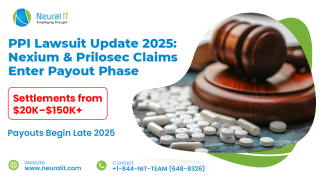Roundup, one of the most commonly and widely used weed killer, contains Glyphosate as one of its main ingredients. Glyphosate is a systemic and broad-spectrum herbicide that was patented by a U.S. company, Monsanto, in 1970. Bayer acquired Monsanto on June 7, 2018.
After the patent for Monsanto expired in the U.S. in 2000 and outside the U.S. in 1991, many other manufacturers started marketing their glyphosate products leading to a substantial increase in sales and global usage. The chemical name of glyphosate is N-(phosphonomethyl) glycine, and it blocks an enzyme in the plant, which helps in preparing amino acids and proteins, thus, killing the plants within a few days.
Initially, the users used Roundup as a non-selective herbicide just like paraquat and diquat. People attempted to use glyphosate-based herbicides to row crops, but crop damage problems restricted its use. In 1996 commercial introduction of a glyphosate-resistant soybean resulted in increased use of Roundup throughout the United States. Monsanto's "Roundup Ready" became the best selling product of the company following the advertisement and the sales increased by around 20% per year between 1990 and 1996.
In 1996, the introduction of a glyphosate-resistant soybean resulted in the growing use of Roundup throughout the United States. Sales of Roundup increased around 20% per year between 1990 and 1996. The product was used in over 160 countries by 2015. It was mostly used on corn, soy, and cotton crops that are genetically designed to resist the chemical. But as of 2012, crops like almond, peach, cantaloupe, onion, cherry, sweet corn, and citrus have been treated by the glyphosate in approximately 5 million acres of California.
Monsanto was accused of false and misleading advertising of glyphosate products in 1996, resulting in a lawsuit by the New York State attorney general. The company claimed that the spray-on glyphosate-based herbicides were non-toxic, safer than table salt, environment friendly, and biodegradable. Later, Monsanto removed the misleading advertisement to settle the case and avoid higher penalties. Some contractors faked the tests conducted on glyphosate along with other pesticides. Craven Laboratories in 1991 and Industrial Bio-Test Laboratories in 1970 conducted toxicology tests by fraudulently analysing samples for residues of glyphosate. Monsanto has even admitted that the studies have since been repeated.
In 2001, environmental and consumer rights campaigners filed a lawsuit against the company as it presented Roundup as biodegradable and left the soil clean after use. Whereas, the European Union identified it as dangerous for the environment and toxic for aquatic organisms.
Since 2013, there was an awareness created that Roundup may lead to some serious medical conditions. It did confirm in March 2015, when the World Health Organization (WHO) announced that there was a probable link between glyphosate and Non-Hodgkin's lymphoma and other forms of cancer. The speculations are that the manufacturer knew about this linkage and covered its tracks unofficially. In December 2018, the city of Sonoma banned the use of glyphosate-based herbicides on all the city properties. While, in January 2019, French authorities officially stopped the sale of Roundup Pro 360, and in March 2019, the city of Miami banned the use of glyphosate-based herbicides in the city’s properties.
IARC, considered to be the apex in the field of cancer research, classified glyphosate as a “probable human carcinogen.” According to IARC, Roundup is made up of other ingredients that are toxic in themselves, and are also known to increase the toxicity of glyphosate. Monsanto has known this for many years but still refuses to study the link between cancer and Roundup.
Monsanto has a brief history of legal troubles and Glyphosate is just another herbicide of the company to attract lawsuits. Plaintiffs across the U.S. have filed numerous lawsuits. A plaintiff from one of the Roundup lawsuits claims that she worked as a grower’s assistant on a crop field in New York from 1994 to 1998 where Roundup was regularly sprayed indoors and outdoors resulting in chronic lymphocytic leukemia in 2012. She eventually quit the job and is currently seeking reasonable compensation and punitive damages in court.
Another case where the plaintiff claimed that he was diagnosed with bone cancer after he was exposed to Roundup while picking vegetables in Oregon from 1986 to 1988, in California from 1988 to 1993 and in Texas from 1993 to 1995. He has quit his work in 1995 and is seeking for compensation and punitive damages.
EPA scientists performed an independent evaluation of available data for glyphosate and found that there was no evidence that glyphosate causes cancer. According to EPA, they considered a more extensive and relevant dataset than the International Agency on the Research for Cancer (IARC). EPA’s cancer classification is consistent with other international expert panels and regulatory authorities, including the Canadian Pest Management Regulatory Agency, Australian Pesticide, and Veterinary Medicines Authority, European Food Safety Authority, European Chemicals Agency, German Federal Institute for Occupational Safety and Health, New Zealand Environmental Protection Authority, and the Food Safety Commission of Japan.
Under EPA’s Endocrine Disruptor Screening Program, Glyphosate has undergone Tier I screening. Based on the available information, EPA concluded, using a weight-of-evidence approach, that the existing data do not indicate that glyphosate has the potential to interact with the androgen, estrogen, or thyroid signaling pathways. Following the recent public comments on the risk assessments, EPA released the Glyphosate Proposed Interim Decision for public comment in April 2019. According to the decision, EPA is management measures on pesticide release height, droplet size, and wind speed to address pesticide spray drift. EPA is also proposing measures to prevent or reduce weed-resistance, which includes giving farmers better information on the mode of action, how to report potential weed resistance issues, and the need for scouting to maintain glyphosate as a tool for growers.
Roundup herbicide was once considered the best gift for agricultural fields. It ruled the market right from the mid-70s until 2013 when some shocking hidden facts were unveiled about this product.
In March 2013 an email sent by a senior toxicologist from Environmental Protection Agency (EPA) to her colleague mentioned the carcinogenic attributes of Roundup herbicide, which were not disclosed to the public due to Monsanto’s strong control over EPA.
Finally, in the year 2015, World Health Organization (WHO) declared that there was a linkage between glyphosate and Non-Hodgkin lymphoma and other types of cancer. Roundup herbicide was labeled as a category 2A- product by the IARC, which means it is probably carcinogenic.
Roundup comprising of active ingredient glyphosate may cause eye or skin irritation. People who breathed in spray mist from products containing glyphosate usually experience irritation in their nose and throat. Swallowing products with glyphosate can cause increased saliva, burns in the mouth and throat, nausea, vomiting, and diarrhea. Fatalities have been reported in cases of intentional ingestion.
Even pets may be at risk if they touch or eat plants that are still wet with spray from products containing glyphosate. Animals exposed to products with glyphosate may drool, vomit, have diarrhea, lose their appetite, or seem sleepy.
Bayer and its Monsanto subsidiary have continued to defend the safety of glyphosate. They have faced massive verdicts in several early trials that have gone forward in the United States, over failure to warn about the risks associated with Roundup exposure. In addition to this, the Roundup manufacturers also got awarded with massive punitive damage designed to punish for withholding safety information from consumers and government regulators.
Pure glyphosate is low in toxicity to fish and wildlife, but some products containing glyphosate may be toxic because of the other ingredients in them. Glyphosate may affect fish and wildlife indirectly because killing the plants alters the animals habitat.
As per the study published in the National Institute of Health, Roundup may negatively affect the good bacteria present in the body's gut. It blocks the shikimate pathway, which is important for both plants and microorganisms
Farmers and people who work closely with these products seem to be at the highest risk of adverse effects.
Glyphosate residues have been found in the blood and urine of farmworkers, especially those who do not use gloves.
Serious Alleged Injuries May Include:
- Non-Hodgkin's Lymphoma
- Leukemia
- Multiple Myeloma
- Other Cancers Or Illnesses
FDA Safety Warnings:
Government Regulations
- The U.S. Environmental Protection Agency (EPA) reviewed glyphosate as non-carcinogenic in 1993. Later, in 2016, it initiated another review to check glyphosate's toxicity and arrived at the same conclusion.
- Contradictory to this, in March 2016, the International Agency for Research on Cancer (IARC) published a report classifying glyphosate as "probably carcinogenic in humans" (category 2A).
- In July 2017, the California Environmental Protection Agency (CalEPA) added Glyphosate to its Proposition 65 list of carcinogenic chemicals.
Legal Updates:
Defendant: Monsanto Company
Defense Law Firms:
Hollingsworth LLP
Winston & Strawn LLP
Arnold and Porter Kaye Scholer LLP
Thompson Coburn LLP
Hartline Dacus Barger Dreyer LLP
Stites & Harbison, PLLC
Husch Blackwell LLP
Shumaker, Loop & Kendrick
Wheeler Trigg O'Donnell LLP
Phelps Dunbar LLP
Richards, Layton & Finger, PA
Ogawa Lau Nakamura & Jew
Ahlers & Cooney, P.C.
Parker Milliken Clark O'Hara and Samuelian PC
Seale & Ross, APLC
Hartline Dacus Barger Dreyer LLP
Wilkinson Walsh Eskovitz LLP
Stoel Rives LLP
Phelps Dunbar LLP
Wilkinson Walsh and Eskovitz
Allegations: Lawsuits filed against Monsanto claim glyphosate exposure from Roundup herbicides causes non-Hodgkin’s lymphoma (NHL) in humans, and plaintiffs blame the company for withholding the cancer risks.
Plaintiffs Co-lead Counsel
Robin Greenwald - Weitz & Luxenberg, PC
Michael Miller - The Miller Firm, LLC
Aimee Wagstaff - Andrus Wagstaff, PC
Lawsuit Status:
Roundup lawsuits have been consolidated under MDL No. 2741 before Vince Chhabria in the U.S. District Court for the Northern District of California.
Monsanto faces more than 10,000 lawsuits as of March 2019, which includes claims that the weed killer causes several types of cancer like non-Hodgkin’s lymphoma (NHL), b-cell lymphoma, leukemia, and others.
Legal Updates
Important Verdicts & Settlements
August 2018: Dewayne Johnson, a former school groundskeeper who was diagnosed with NHL, was awarded $289 million on August 10, 2018, by a San Francisco jury.
October 2018: San Francisco Superior Court Judge Suzanne Bolanos reduced Dewayne Johnson’s award to $78 million in October 2018.
February 2019: The first bellwether trial went before a jury on February 25, 2019, concerning a lawsuit filed by plaintiff Edwin Hardeman in San Francisco, California.
March 2019: Monsanto’s Summary Judgment Motion to escape a series of bellwether cases lined up against it over the hazards of the controversial weed killer, Roundup was rejected by the MDL Judge.
March 2019: A California man, Edwin Hardeman, was awarded $80 million in damages by a San Francisco jury in the first federal trial against Monsanto, as the jury found that glyphosate exposure from Roundup was the reason for the man's cancer.
Evidence:
- Extent Of Exposure To Roundup Herbicide, Such As Farm Laborer/Gardener.
- Details For Roundup Herbicide Usage, Duration And Type Of Contact.
- Health Complications/Injuries In Medical Records
- Severity And Treatment For Complications/Injuries In Medical Records
- Linkage Of Complications/Injuries And Roundup Usage
Medical Record Review and claim validation of Roundup case should take approximately 3 hours in most instances; however, this approximation may vary in cases based on the volume of records.





